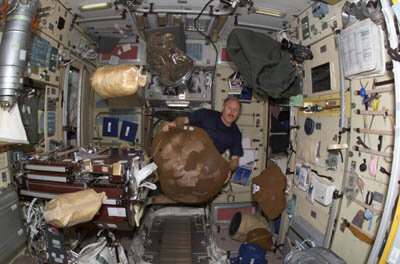Challenge to European designers: use space to make space
ESA is challenging European design students to create products featuring new interior storage concepts by applying 'space methods' to life here on Earth.
What any spacecraft most lacks is physical space itself. With the high cost of delivering payload, every cubic centimetre of interior volume is exploited as efficiently as possible. So astronauts have to live at extremely close quarters, while engineers are driven to develop new methods of volume management and storage.
Now the Agency has issued a brief – called 'From Outer Space To Inner Space – Implications For Innovative Storage Design' - as part of the 2nd DA&D NESTA Joint Product Design and Innovation Awards.
It asks for a product featuring a new storage concept, designed for any interior, from a room of a home to inside a car. But it must incorporate techniques, technologies or materials developed for space or used extensively in it.

This competition is open to undergraduate and postgraduate student designers across Europe. Three winners will be selected by the Awards jury in June 2004, and each given funding and encouragement to develop their ideas.
The Awards are organised jointly by D&AD (Design & Art Direction), an organisation representing Britain's design and advertising communities and NESTA (the National Endowment for Science, Technology and the Arts), a body encouraging innovation in UK science, technology and the arts.
ESA's brief was set by David Raitt, Senior Officer in ESA’s Technology Transfer Programme: “This is another great opportunity to show the importance of space technology and materials being made available to the general public to improve daily life.”
Managing space in space presents a challenge. Weightlessness abolishes 'up' and 'down'. Floors and ceilings become meaningless as all surfaces are equally accessible. At the same time astronauts spending long periods in confined spaces require a certain amount of uncluttered physical space to work and maintain psychological health.

A wide variety of tools and other items must be kept stowed away when not in use so a distinctive feature of the International Space Station's interior are modular locker racks or 'soft stowage' bags set into the walls.
Of increasing importance in space management are designs or materials that change their shape in orbit, used to achieve large volume reduction for pre-launch packing. For instance, solar arrays and antennae begin their journey to orbit folded up along the hull. Once in orbit these attachments unfurl or extend to full size and function.
The ESA Awards brief is one of three in this competition. The others are Conran & Partners for designing cutlery for use with all types of meals worldwide and Britain's Design Council for redesigning a common object or service to increase its business potential and decrease its environmental impact.
For more information on the DA&D NESTA Product Design & Innovation Awards, and to download the entry form, go to British Design & Art Direction (D&AD).
The closing date for entries is 26 March 2004.




